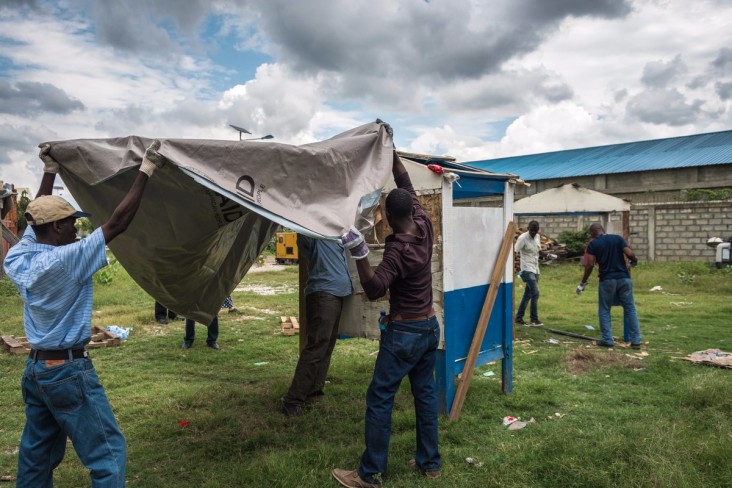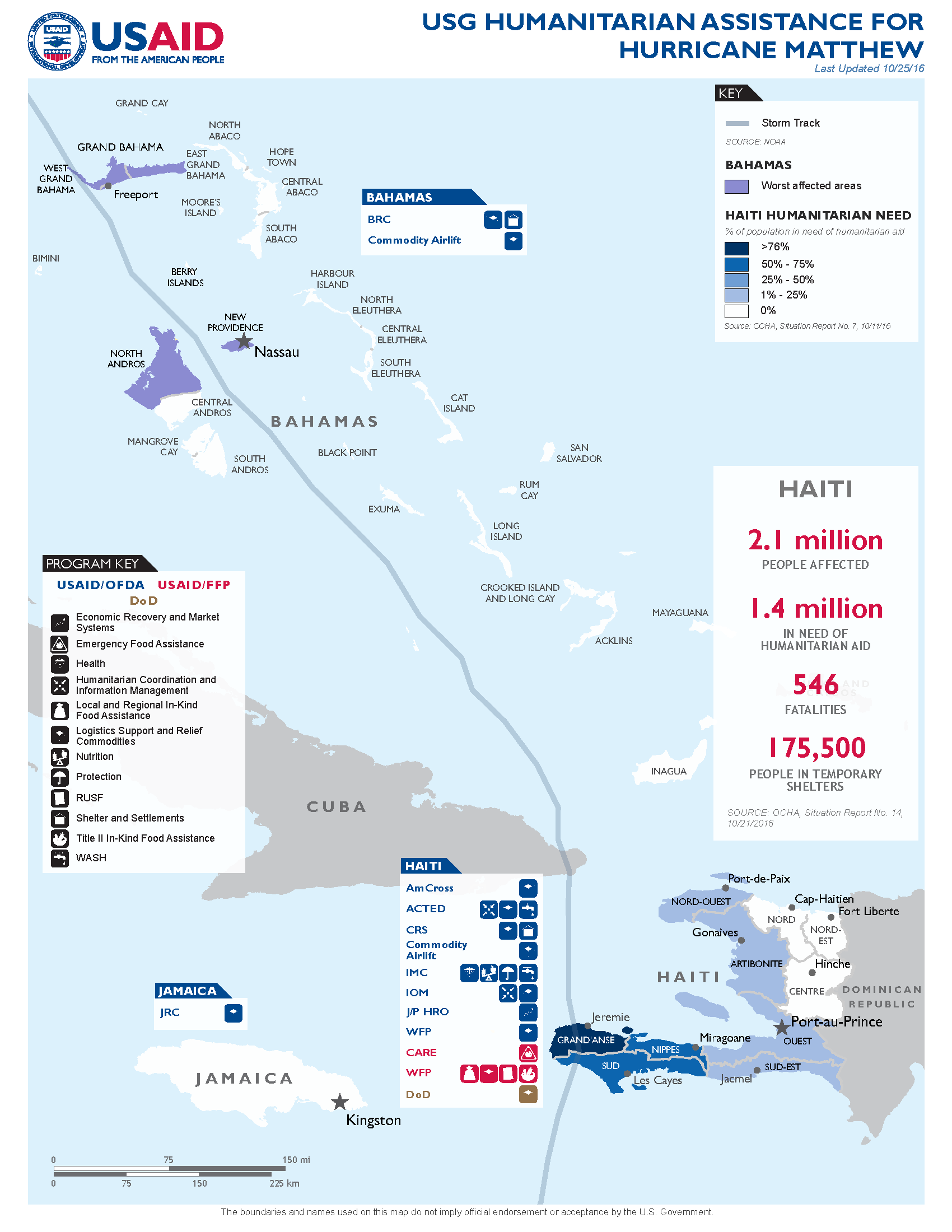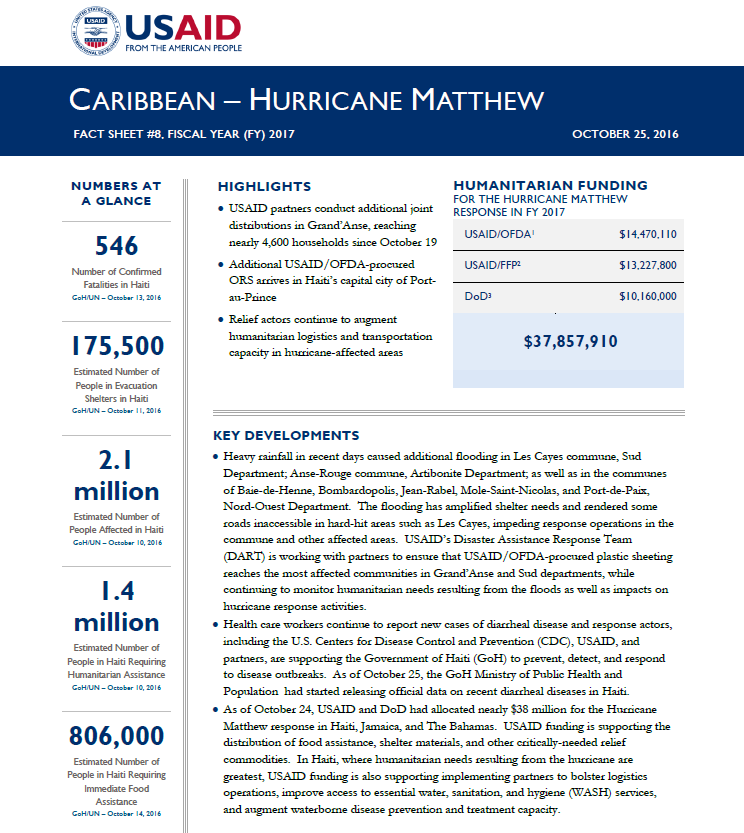
October 25, 2016
Highlights
USAID partners conduct additional joint distributions in Grand’Anse, reaching nearly 4,600 households since October 19.
Additional USAID/OFDA-procured ORS arrives in Haiti’s capital city of Port-au-Prince
Relief actors continue to augment humanitarian logistics and transportation capacity in hurricane-affected areas
Key Developments
Numbers At A Glance
546
175,509
2.1 million
1.4 million
806,000
Humanitarian Funding
For the Hurricane Matthew Response
in FY 2017
| USAID/OFDA | $14,470,110 |
| USAID/FFP | $13,227,800 |
| DoD | $10,160,000 |
| TOTAL | $37,857,910 |
Heavy rainfall in recent days caused additional flooding in Les Cayes commune, Sud Department; Anse-Rouge commune, Artibonite Department; as well as in the communes of Baie-de-Henne, Bombardopolis, Jean-Rabel, Mole-Saint-Nicolas, and Port-de-Paix, Nord-Ouest Department. The flooding has amplified shelter needs and rendered some roads inaccessible in hard-hit areas such as Les Cayes, impeding response operations in the commune and other affected areas. USAID’s Disaster Assistance Response Team (DART) is working with partners to ensure that USAID/OFDA-procured plastic sheeting reaches the most affected communities in Grand’Anse and Sud departments, while continuing to monitor humanitarian needs resulting from the floods as well as impacts on hurricane response activities.
Health care workers continue to report new cases of diarrheal disease and response actors, including the U.S. Centers for Disease Control and Prevention (CDC), USAID, and partners, are supporting the Government of Haiti (GoH) to prevent, detect, and respond to disease outbreaks. As of October 25, the GoH Ministry of Public Health and Population had started releasing official data on recent diarrheal diseases in Haiti.
As of October 24, USAID and DoD had allocated nearly $38 million for the Hurricane Matthew response in Haiti, Jamaica, and The Bahamas. USAID funding is supporting the distribution of food assistance, shelter materials, and other critically-needed relief commodities. In Haiti, where humanitarian needs resulting from the hurricane are greatest, USAID funding is also supporting implementing partners to bolster logistics operations, improve access to essential water, sanitation, and hygiene (WASH) services, and augment waterborne disease prevention and treatment capacity.
HUMANITARIAN ACCESS AND LOGISTICS SUPPORT
As of October 22, recent rainfall and subsequent flooding had resulted in at least five deaths and prompted the evacuation of an estimated 2,300 people in Baie-de-Henne and Mole-Saint-Nicolas. Floodwaters also affected more than 160 households in Anse-Rouge; damaged WASH infrastructure in Jean-Rabel; and rendered some roadways in affected areas impassable, according to the GoH Directorate of Civil Protection (DPC). The inundation has also disrupted planned distributions of emergency food assistance and relief commodities in Les Cayes and was contributing to delays in humanitarian air operations throughout hurricane-affected areas, according to the DART and other Logistics Sector Working Group members.
USAID partners, including J/P Haitian Relief Organization (J/P HRO), the International Organization for Migration (IOM), and the UN World Food Program (WFP) continue efforts to restore road access and strengthen logistics and transportation capacity amid the challenging operating context.
To support the transportation of food and relief items, as well as humanitarian personnel, to affected areas, WFP maintains two operational air assets and 15 off-road vehicles, positioned in Jeremie and Les Cayes. From October 19–20, WFP air assets transported cholera kits and four health care workers to Randel town, Sud, as well as food assistance, hygiene kits, and shelter supplies to Sud’s Camp Perrin commune and Grosse Cayes Island.
In coordination with the DART, IOM, and WFP, the GoH DPC has activated a central clearinghouse in Port-au-Prince to process relief actor requests for food and relief commodities, as well as transportation services. As of October 21, the DPC-led clearinghouse had processed nearly 70 requests for relief supplies from more than 40 humanitarian organizations. The clearinghouse had also processed six requests for emergency food assistance from three organizations planning to conduct food distributions in Grand’Anse, Nippes, Ouest, and Sud departments. Additionally, the logistics clearinghouse had coordinated storage services in Port-au-Prince and Les Cayes for 15 organizations and road and sea transport for more than 10 organizations.
FOOD ASSISTANCE AND RELIEF COMMODITIES
The October–November period typically marks the second harvest season in Haiti; however, the hurricane destroyed an estimated 70–100 percent of crops in affected areas. The absence of a second harvest, with the accompanying reduction in agricultural income-earning opportunities, is expected to exacerbate food needs across Grand’Anse and Sud, with persistent food consumption gaps possibly increasing acute malnutrition, according to the GoH and the USAID-funded Famine Early Warning Systems Network.
The UN Food and Agriculture Organization anticipates that cereal import requirements—including emergency food aid as well as commercial imports—in Haiti will reach a record level of 680,000 tons due to hurricane-related crop losses.
USAID partners the Agency for Technical Cooperation and Development (ACTED), IOM, and WFP distributed food and relief supplies to more than 900 households in the Jeremie’s Sainte-Helene neighborhood on October 23. Since October 19, the joint ACTED, IOM, and WFP distributions have reached nearly 4,600 households in Jeremie with food and relief supplies.
From October 8–23, WFP reached approximately 202,500 people in Grand’Anse, Nippes, and Sud with 1,510 metric tons (MT) of food assistance. Overall, the UN agency had dispatched 3,000 MT of food to hurricane-affected areas in Haiti as of October 23.
HEALTH AND WASH
Given the increased risk of waterborne disease transmission following the hurricane, USAID/OFDA airlifted an additional 800,000 packets of oral rehydration solution (ORS) for treatment of acute watery diarrhea to Haiti on October 24. Cumulatively, USAID/OFDA has provided 1.5 million ORS packets to Haiti. The 1.5 million supply is sufficient to treat approximately 150,000 cases of mild-to-moderate diarrheal disease.
With nearly $1.2 million in USAID/OFDA support, the International Medical Corps (IMC) is supporting mobile health clinics in Sud’s Aquin, Chardonnieres, Les Anglais, Roche-a-Bateaux, Saint-Jean-du-Sud, and Tiburon communes, as well as an 18-bed cholera treatment unit in Les Anglais. The mobile clinics are identifying and referring suspected cases of cholera and other diarrheal diseases to health facilities, thereby increasing surveillance and facilitating access to treatment for patients. USAID/OFDA funding is also supporting IMC to improve access to essential WASH services and infrastructure in health facilities and temporary shelters.
CDC and USAID/OFDA WASH advisors continue to assist the GoH National Directorate of Water Supply and Sanitation (DINEPA) to assess the functionality of piped community water systems and support repair and rehabilitation efforts. CDC is also supporting DINEPA to assess WASH needs among populations in temporary shelters.
The GoH plans to launch an oral cholera vaccination campaign in early November, targeting populations in nine of Sud’s communes and five of Grand’Anse’s communes. CDC plans to support monitoring and evaluation activities, including conducting coverage and vaccine effectiveness surveys, alongside the vaccination campaign. In addition, CDC is providing training materials for cholera case management to health facilities, including cholera treatment centers.
SHELTER
With the National Meteorological Center of Haiti forecasting heavy rainfall to continue in the coming days, the GoH DPC is urging response actors to prioritize the rapid distribution of plastic sheeting to affected areas. The DART is working with partners to ensure that USAID/OFDA-procured plastic sheeting—comprising more than 3,500 rolls sufficient to meet the emergency shelter needs of up to 175,000 people—reaches hard-hit communities in Grand’Anse and Sud, while continuing to monitor humanitarian needs resulting from the floods as well as impacts on hurricane response activities.
To help address the urgent need for plastic sheeting in Grand’Anse’s Moron commune, particularly amid the current rains, non-governmental organization CARE distributed USAID/OFDA-supplied plastic sheeting to more than 950 households from October 22–23. According to local officials, an estimated 80 percent of residential roofs across the commune sustained damage due to the hurricane.
The UN’s flash appeal for Haiti requests $12.4 million to ensure that emergency shelter supplies—including plastic sheeting and tools—and relief items reach 70,000 extremely vulnerable households. As of October 25, two other international donors—the Central Emergency Response Fund (CERF), a pooled humanitarian fund established and managed by the UN to support underfunded emergencies, as well as the Government of Sweden—had pledged support for planned shelter activities, according to the Office for the Coordination of Humanitarian Affairs (OCHA) Financial Tracking Service (FTS). Response actors, however, continue to express concern that the funding allocated for shelter activities by international donors, as well as in the UN’s appeal, remain inadequate given the magnitude of damage caused by Hurricane Matthew.
OTHER HUMANITARIAN ASSISTANCE
On October 21, the Government of Japan (GoJ) pledged $3 million for humanitarian relief and recovery efforts in Haiti. GoJ assistance will enable the International Federation of Red Cross and Red Crescent Societies, the UN Development Program, UNICEF, and WFP to provide emergency food and relief commodities, conduct health and WASH interventions, and support early recovery efforts in hurricane-affected areas. Additionally, the Government of the Republic of Korea has announced $500,000 in support for the Hurricane Matthew response.
Other international donors had contributed approximately $32.4 million for the Hurricane Matthew response as of October 25, according to OCHA’s FTS. The funding includes more than $16.5 million—approximately 14 percent—toward the UN’s $119.9 million flash appeal.
CONTEXT
Hurricane Matthew made initial landfall near Haiti’s Les Anglais commune, Sud, and secondary landfall over eastern Cuba on October 4 before continuing to traverse The Bahamas from October 5–7. The hurricane brought destructive winds, heavy rainfall, and dangerous storm surge, resulting in extensive damage to crops, houses, and infrastructure, as well as widespread flooding in some areas.
On October 2, U.S. Ambassador to Haiti Peter F. Mulrean and U.S. Chargé d’Affaires, a.i., for Jamaica Eric Khant issued disaster declarations in response to the anticipated effects of Hurricane Matthew. U.S. Chargé d’Affaires, a.i., Lisa A. Johnson issued a disaster declaration in response to the anticipated effects of Hurricane Matthew in The Bahamas on October 4.
USAID activated a regional DART on October 3 with staff in The Bahamas, Haiti, and Jamaica. USAID also stood up a Washington, D.C.-based Response Management Team to coordinate the regional humanitarian response.
Based on assessment findings and in consultation with government representatives in the two countries, USAID discontinued DART operations in Jamaica and The Bahamas on October 5 and 13, respectively. USAID/OFDA regional staff will continue to monitor USAID/OFDA assistance provided to the Bahamas Red Cross (BRC) and the Jamaica Red Cross (JRC) to address the immediate needs of populations affected by Hurricane Matthew.









Comment
Make a general inquiry or suggest an improvement.